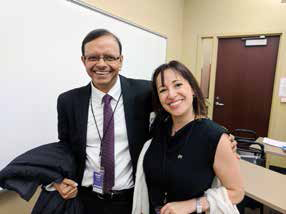Empowering NGOs and finding solutions to deeprooted equity issues may sometimes be as important and it is vital that Indian philanthropy takes a guided approach to first multiplying and then directing its resources at addressing the country’s multiple problems

A week in the USA – focused on understanding the science and art of philanthropy was an eye-opener in more ways than one. So many opportunities to learn and also to collaborate! In three separate interactions—in Chicago, New York and Connecticut, there were moments of epiphany and many thoughts on what we must do, as a country and even as a bunch of well-meaning individuals if we have to reduce the numerous social inequities and build an inclusive nation.
The annual meet of Social Venture Partners International in Chicago saw the assembly of over 200 well-intentioned philanthropists drawn from the 3,000-plus SVP partners from all over the world who have chosen to make SVP their mediumof social expression. The four days saw wide-ranging case study presentations, discussions on equity of all kinds—economic, race, class, gender, etc. and it was interesting to see the differences in equity perceptions in the USA, Australia, Japan, China and India, to name just a few of the participating countries. The SVP model has always been unique in the approach to venture philanthropy, bringing people together in cities around the world to collaborate for a shared social impact agenda. In a country like India or a state like Connecticut in the US, the choice of one community agenda like skills to put youth to work becomes a rallying point for many like our Million Jobs Mission is doing across all SVP locations in India.
 Uma Ganesh speaking at a SVP Workshop in Connecticut, USA
Uma Ganesh speaking at a SVP Workshop in Connecticut, USAIn Connecticut, where my wife Uma and I did a workshop with many of the local SVP partners, the agenda identified is two-fold… to substantially enhance the quality of the community colleges and find solutions to employment needs of the large manufacturing base, particularly defence manufacturing in that state. The opportunity to offer blended learning solutions that could bring compelling content and educational pedagogy to solve this problem is very similar to the agenda that India has to bring much-needed quality to education institutions and skill building institutions in every location and domain.
Finally, an opportunity to attend a fund-raising lunch for the Black Forest in the Hudson Valley in New York gave us an insight into the methodology of meaningful fund-raising in the US. Attended by over a hundred well-intentioned environment- conscious New Yorkers, the lunch provided insights into some real issues and an opportunity to understand the various solutions being explored. In the words of the keynote speaker, it is an imperative to avoid “scenic Hudson presenting a sight similar to that which one encounters coming out of a busy Delhi metro station” and the fact that over 400,000 dollars were raised in just that hour shows the quantum of intent and money that is available for good causes in the USA. According to Giving USA 2017, the annual report on philanthropy in the USA, philanthropic giving touched 400 billion dollars with charitable giving from individuals, foundations and corporations all increasing over the years.
The SDGs (Social Development Goals) could play an important role in guiding social activity in the country
 Ganesh Natarajan with Sofia, Chairperson of Social Venture Partners International
Ganesh Natarajan with Sofia, Chairperson of Social Venture Partners InternationalIn the case of corporations, the percentage rise in giving showed a sharp correlation with the rise in pre-tax profits, a sure justification for our own Government’s visionary idea of suggesting that every large company in India should donate 2% of their last three years’ average profits to charitable causes through CSR.
Renowned economist Lucas Chancel has suggested that income inequality in India is at its highest level since 1922 with India’s richest one percent holding over fifty-eight percent of the country’s total wealth. Another report which collates views of some India’s leading thinkers in the philanthropy area and the Bill and Melinda Gates Foundation, faults lack of donor education about local contexts with the result that many individuals and foundations make a beeline to fund education whereas the problem may point to other solutions in many parts of the country. Empowering NGOs and finding solutions to deep-rooted equity issues may sometimes be as important and it is vital that Indian philanthropy takes a guided approach to first multiplying and then directing its resources at addressing the country’s multiple problems.
The SDGs (Social Development Goals) could play an important role in guiding social activity in the country. Formulated as a set of 17 cross-cutting goals lead by the United Nations with the aim of eradicating poverty by 2030, they bring in a much-needed impact measurement component that forces the need for data capture and analysis to guide funders towards better outcomes.
Much to think about and certainly time to act!
By Ganesh Natarajan